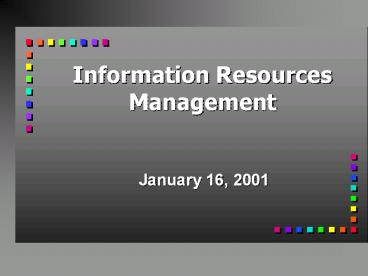Information Resources Management PowerPoint PPT Presentation
1 / 38
Title: Information Resources Management
1
Information Resources Management
- January 16, 2001
2
Agenda
- Administrivia
- Course Overview
- Database Management Systems (DBMSs)
- Homework 1
3
Administrivia
- Syllabus
- Book
- Homework
- Web Page
4
Course Calendar
- Eleven Homeworks
- Approximately one per week
- Exams
- Midterm 1 - 2/20
- Midterm 2 - 3/20
- Final - TBA
- Quizzes
- Up to five
5
Overview Perspective
- Database Design and Implementation
- Business Perspective
- IT professional in an organization
6
Database Design
- Relational Model
- Database Modeling
- Evaluation Tools
- Normalization
7
Database Implementation
- SQL (Structured Query Language)
- Dependability, Reliability
- Architecture
- Distributed Databases
8
Database Management Systems
- Traditional File Processing Systems
- Database
- Comparison
- Database Lifecycles
- Database Management System Functions
9
Traditional File Processing System
- Separate Files
- Department
- Business Function
- Independent of Each Other
- High Level of Program Dependence
- Program contains file structure and location
10
Example
Time Cards
Sorted by Employee
Trans
Master
Data Entry
Sort by Employee
Update Master
Trans
New Master
Report
Checks
11
Data Abstraction (Views)
- Physical/Internal
- Logical/Conceptual
- View/External
- How data is stored
- What is stored
- What is used (subset)
Traditional file processing prevents this
abstraction. Why?
12
Three Views of Data
External (View) Client Customer Programmer
Conceptual (Logical) Designer Database
Administrator (DBA)
Internal (Physical) Database Administrator
(DBA) Tech Support
13
What is Needed
- Physical Independence
- Logical Independence
14
Physical Independence
- Physical layout and organization of data can be
changed without changing either the overall
logical structure of the data or the application
programs - Examples
- Move data location
- Move data to faster storage
- Change indexing
- Add a secondary key
15
Physical Independence
External (View)
Conceptual (Logical)
Internal (Physical)
No Resulting Change Here
Change Here
16
Logical Independence
- Non-loss changes to the logical structure can be
made without changing application programs or
end-user views - Examples
- Change format of a field (zip from 5 to 9)
- Add a new data field
- Add a new table
- Divide a table into two
17
Logical Independence
External (View)
Conceptual (Logical)
Internal (Physical)
No Resulting Change Here
Change Here
Coordinating Change Here
18
Database
- organized collection of logically related data
- shared collection of interrelated data designed
to meet the informational needs of multiple users - data is independent of program and user views
- data is stored with physical and logical
independence
19
Database Management System (DBMS)
- Software that facilitates the implementation of
the database concept
20
Comparison(Traditional vs. Database)
- Database Advantages/Traditional Disadvantages
- program-data dependence
- duplication
- data sharing
- development times
- program maintenance ripple effects
- flexibility
21
Comparison(Traditional vs. Database)
- Database Advantages/Traditional Disadvantages
- security
- data integrity
- data as corporate resource
22
Comparison(Traditional vs. Database)
- Traditional Advantages/Database Disadvantages
- size
- complexity
- cost
- special hardware
- impact of failure
- recovery
23
Comparison(Traditional vs. Database)
- Traditional Advantages/Database Disadvantages
- additional personnel
- conversion costs
- organizational conflict
24
Database Lifecycle
- 1. Enterprise Modeling
- 2. Conceptual Data Modeling
- 3. Logical Database Design
- 4. Physical Database Design and Creation
- 5. Database Implementation
- 6. Database Maintenance
25
People Involved
- Systems analysts designers
- Database analysts designers
- Users
- Programmers
- Database Administrators (DBAs)
- Networking experts
- Other technical experts
26
Database Management System Functions
- data storage, retrieval and update
- user-accessible catalog
- transaction support
- concurrency control
- recovery services
- authorization services
- support for data communication
27
Database Management System Functions
- integrity services
- types - character, number, etc.
- internal validity
- services to promote data independence (logical
and physical) - utility services
28
Database Applications
- Personal
- one user
- Workgroup
- small team - LAN connected
- Department/Division
- multiple teams and functions
- Enterprise
- entire organization
29
In-Class Exercise
- Groups of 4
- Introduce yourself
- Identify a possible database of each type
- Pick a speaker
30
In-Class Exercise
- Introduce yourself and group members
- Give groups example databases
- personal
- workgroup
- department/division
- enterprise
31
Personal Databases
- Benefits
- individualized
- meet specific needs
- purchased package
- Drawbacks
- limited to no data sharing
- replicated data
- consolidation - standardization
- support
32
Workgroup Databases
- Benefits
- meet specific needs
- data shared (across group)
- customized views
- Drawbacks
- data sharing across groups
- replicated data
- security
- not optimal for individual
- DBMS cost support
33
Department Databases
- Benefits
- meet (specific) needs
- data shared
- Drawbacks
- data sharing
- replicated data
- security
- not optimal for individual/group
- performance
- DBMS cost development
34
Enterprise Databases
- Benefits
- meet needs
- data shared
- mineable
- consistent view to customers
- Drawbacks
- size complexity
- security
- cost support
- development
- standards bureaucracy
- distribution ownership
35
Best Database?
- Personal?
- Workgroup?
- Department?
- Enterprise?
36
Best Database?
- Personal?
- Workgroup?
- Department?
- Enterprise?
- Combination of databases that meets the needs of
individuals, teams, departments, and the company
37
Best Database?
- To the individual, its a personal database
- To the team, its a workgroup database
- To the department, its a department database
- To the CEO, its an enterprise database
- (To the DBA, its a headache)
38
Homework 1
- Data management recommendation
- High-level, experience based
- glossy vendor material
- Show
- alternatives
- strengths/weaknesses of each
- well-reasoned explanation

